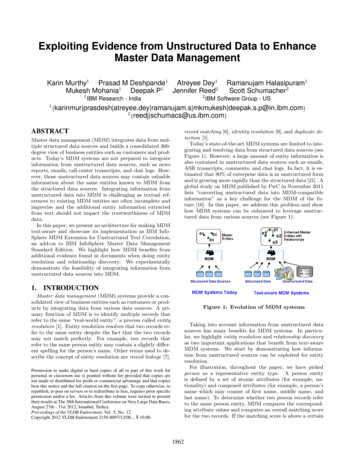
Transcription
Best Practices to Enhance theEmployability of Opportunity Youth:A Synthesis of the Available LiteraturePrepared by:Center for Human Services ResearchUniversity at AlbanyPrepared for:City of Albany Poverty Reduction Initiative (CAPRI)CARES, Inc.AUGUST 2017
08 2017Best Practices to Enhance the Employability of Opportunity Youth:A Synthesis of the Available LiteratureINTRODUCTION: Defining Opportunity YouthIn the United States, millions of young people lack the necessary experience and skills to succeedin the labor market. This employment skills gap affects non-white youth at disproportionate ratescompared to their white counterparts (Urban Alliance, 2014). Nationally, an estimated 3 millionpeople between the ages of 16 and 24 are neither in school or working, with blacks and Latinosbeing 3-to-6 times more likely to fall into this category (Svajlenka, 2016).An analysis of Census data reveals that the Cityof Albany has approximately 1000 youth neither inschool nor employed, with the highest proportionin West Hill, Arbor Hill, and the South End (SeeTable 1). About 85% of these youth are betweenthe ages of 20 and 24. Two thirds are racial minorities, and eleven percent of black youth areunemployed and not in school compared to twopercent of white youth (U.S. Department of Commerce, 2015).TABLE 1. Demographics of OpportunityYouth in ckWhiteAsianMultiracial49%33%12%6%Youth unemployment has collateral consequences on the affected youth, the economy, and society in general. Youth unemployment is a predictor of future negative outcomes including longterm unemployment, poverty, criminal behavior, and substance abuse (Svajlenka, 2016). According to an Urban Alliance policy brief, “each young person who disconnects from school or workcosts an estimated 704,020 over his or her lifetime in lost earnings, lower economic growth,lower tax revenues, and higher government spending. For all disconnected youth in this country,the aggregate taxpayer burden is 1.56 trillion and the social cost is 4.75 trillion” (Urban Alliance,2014). Youth employability initiatives have been devised as one mechanism for mitigating thisissue and attempting to close the employment skills gap.Identifying Best Practices in YouthEmployment ProgramsIncorporating best practices in program models is critical because these practices have beenshown through research and experience to produce optimal results. However, identifying the bestpractice components to inform new program development is complicated as youth employmentinitiatives vary significantly in the population they serve and the services they offer. Drawing fromthe National Youth Employment Coalition’s Effective Practices Criteria Workbook, review articles,and information from youth employment program models, Collura (2010) identified ten effectiveprogrammatic practices that are consistently present in the most successful youth employmentprograms. Data for the present review were collected by consulting similar sources, analyzingexisting program models, and interviewing experts in the field. Results from this review providesupport for Collura’s (2010) findings. This review discusses and expands upon these findings.2The best practices discussed in this review are intended only to provide a general framework. Aswill be discussed, youth employment programs models and the best practices they employ arehighly dependent on the individual needs of the initiative’s participants. That being said, someor all of the following best practices are consistently present in successful youth employmentprogram models.
08 20171Best Practices to Enhance the Employability of Opportunity Youth:A Synthesis of the Available LiteratureBEST PRACTICE: Specify an Explicit TargetPopulation and Program GoalsEffective programs will have a clearly defined mission that specifies the population of youth thatthe program is targeting, the outcomes the program aspires to achieve, and the specific strategies that the program will implement to attain these outcomes (Collura, 2010; O’Sullivan, 2000;Weinbaum & Wirmusky, 1994). There is no single “best model” for effective youth employmentprograms, as practices will vary based on the target population. Accordingly, effective programsdo not attempt to serve everyone, and instead recruit and select participants that are most likelyto benefit from the program (O’Sullivan, 2000). Goals of youth employment programs will differ based on their target population. While all youth employment programs share the commongoal of increasing the employability of its participants, some will place more of an emphasis oneducational attainment and others on vocational training (Jekielek, Cochran, & Hair, 2002). Forexample, a program that is targeting youth who have dropped out of school will likely include aneducational component such as a GED program, whereas, programs that target youth who arecurrently enrolled in high school may focus more on vocational skills. It is critical that “there is alogical relationship between the initiative’s mission, activities, and the youth it serves” (O’Sullivan,2000, p. 20). Most programs will thus find it useful to develop a logic model connecting its strategies and desired outcomes.2BEST PRACTICE: Focus on Employability SkillsThe Entry-Level Job Requirement survey conducted by the Seattle Jobs Initiative asks employers about what skills they value and expect job applicants to possess for entry-level positions.Results suggest that the majority (77%) of employers believe that soft skills, such as time management, teamwork, and professional communication, are as or more important than technicalskills for securing entry-level employment at their companies. Furthermore, employers stated thatthey were hesitant or unwilling to hire candidates that lack soft skills, with 87.8% of respondentsindicating that they assess the soft skills of applicants by observing how they conduct themselvesduring a job interview (Pritchard, 2013). There is often a gap between the skills required to successfully navigate the labor market and the skills that are taught in schools (Kim, 2015). Effectiveyouth employment programs should seek to fill this gap, and in order to accomplish this, theymust have a sophisticated understanding of the specific competencies that employers in thepresent labor market are seeking.The Secretary’s Commission on Achieving Necessary Skills (SCANS) and Jobs for America’sGraduates (JAG) can be valuable resources for developing this understanding. SCANS membership was appointed by the Secretary of Labor to determine the specific skills young peopleneeded to succeed in the workplace. In 1991, the commission released their report, What WorkRequires of Schools, providing a general framework of employability skills (The Secretary’s Commission on Achieving Necessary Skills, 1991) (See Table 2). While a useful resource, a limitation ofSCANS is that the framework lacks specificity (Collura, 2010).3
08 2017Best Practices to Enhance the Employability of Opportunity Youth:A Synthesis of the Available LiteratureTABLE 2: SCAN’S THREE-PART FOUNDATIONBASIC SKILLS: Reads, writes, performs arithmetic and mathematical operations, listensand speaks Reading locates, understands, and interprets written information in prose and in documentssuch as manuals, graphs, and schedulesWriting communicates thoughts, ideas, information, and messages in writing; and createsdocuments such as letters, directions, manuals, reports, graphs, and flow chartsArithmetic/Mathematics performs basic computations and approaches practical problems bychoosing appropriately from a variety of mathematical techniquesListening receives, attends to, interprets, and responds to verbal messages and other cuesSpeaking organizes ideas and communicates orallyTHINKING SKILLS: Thinks creatively, makes decisions, solves problems, visualizes,knows how to learn, and reasons Creative Thinking generates new ideasDecision Making specifies goals and constraints, generates alternatives, considers risks, andevaluates and chooses best alternativeProblem Solving recognizes problems and devises and implements plan of actionSeeing Things in the Mind’s Eye organizes, and processes symbols, pictures, graphs, objects,and other informationKnowing How to Learn uses efficient learning techniques to acquire and apply new knowledgeand skillsReasoning discovers a rule or principle underlying the relationship between two or more objectsand applies it when solving a problemPERSONAL QUALITIES: Displays responsibility, self-esteem, sociability, selfmanagement, and integrity and honesty Responsibility exerts a high level of effort and perseveres towards goal attainmentSelf-Esteem believes in own self-worth and maintains a positive view of selfSociability demonstrates understanding, friendliness, adaptability, empathy, and politeness ingroup settingsSelf-Management assesses self accurately, sets personal goals, monitors progress, andexhibits self-controlIntegrity/Honesty chooses ethical courses of actionSource: The Secretary’s Commission on Achieving Necessary Skills, 19914JAG provides a more detailed framework. The JAG National High School Employability SkillsCurriculum consists of 81 specific competencies broken down into eight categories: career development, job attainment, job survival, basic competencies, leadership and self-development,personal skills, life survival skills, and workplace competencies (JAG Annual Report, 2015) (seeTable 3). Neither of the aforementioned resources are exhaustive and are only intended to providea basic framework for understanding the skills that youth employment programs may want to beteaching their participants.
08 2017Best Practices to Enhance the Employability of Opportunity Youth:A Synthesis of the Available LiteratureTABLE 3: JAG NATIONAL HIGH SCHOOL CURRICULUM FOR COMPETENCY-BASED EMPLOYABILITY SKILLSNational High School Curriculum5A. Career Development CompetenciesA.1 Identify occupational interests, aptitudes and abilitiesA.2 Relate interests, aptitudes and abilities to appropriate occupationsA.3 Identify desired life style and relate to selected occupationsA.4 Develop a career path for a selected occupationA.5 Select an immediate job goalA.6 Describe the conditions and specifications of the job goalB. Job Attainment CompetenciesB.7 Construct a résuméB.8 Conduct a job searchB.9 Develop a letter of applicationB.10 Use the telephone to arrange an interviewB.11 Complete application formsB.12 Complete employment testsB.13 Complete a job interviewC. Job Survival CompetenciesC.14 Demonstrate appropriate appearanceC.15 Understand what employers expect of employeesC.16 Identify problems of new employeesC.17 Demonstrate time managementC.18 Follow directionsC.19 Practice effective human relationsC.20 Appropriately resign from a jobD. Basic CompetenciesD.21 Comprehend verbal communicationsD.22 Comprehend written communicationsD.23 Communicate in writingD.24 Communicate verballyD.25 Perform mathematical calculationsE. Leadership and Self Development CompetenciesE.26 Demonstrate team membershipE.27 Demonstrate team leadershipE.28 Deliver presentations to a groupE.29 Compete successfully with peersE.30 Demonstrate commitment to an organizationF. Personal Skills CompetenciesF.31 Understand types of maturityF.32 Identify a self-value system and how it affects lifeF.33 Base decisions on values and goalsF.34 Identify process of decision-makingF.35 Demonstrate ability to assume responsibility for actions anddecisionsF.36 Demonstrate a positive attitudeF.37 Develop healthy self-concept for home, school and workG. Life Survival SkillsG.38 Evaluate a career plan to determine appropriate postsecondaryeducational optionsG.39 Identify how best to achieve marketable occupation skills foran entry level jobG.40 Conduct a job analysisG.41 Apply critical thinking skillsG.42 Demonstrate effective study skillsG.43 Demonstrate how to use group dynamics techniquesG.44 Explain the roles and function of a value-added organizationSource: JAG Annual Report, 2015G.45 Understand the essential elements of high performing workteamsG.46 Describe how to work and communicate with diverse peopleat work and in the community to satisfy their expectationsG.47 Demonstrate techniques for building commitment by othersG.48 Demonstrate an openness to changeG.49 Provide constructive feedbackG.50 Negotiate solutions to conflictsG.51 Demonstrate politeness and civilityG.52 Demonstrate an ability to adapt to people and situationsG.53 Exhibit work ethics and behaviors essential to successG.54 Set and prioritize goals and establish a timeline for achievingthemG.55 Apply the problem solving process to complex problemsG.56 Demonstrate an ability to analyze the strengths and weaknesses of self and othersG.57 Design and justify solutions by tracking and evaluating resultsG.58 Identify ways to build mutual trust and respectG.59 Prepare a short- and long-term personal budgetH. Workplace CompetenciesH.60 Demonstrate punctuality and good attendance practicesH.61 Demonstrate initiative and proactivityH.62 Demonstrate how to work effectively with othersH.63 Demonstrate an attitude that attracts the attention ofmanagementH.64 Demonstrate an ability to communicate and work with customers to satisfy their expectationsH.65 Demonstrate listening skills which will result in gaining aclear understanding of information being conveyedH.66 Demonstrate an ability to follow and give directionsH.67 Demonstrate good reasoning skills which results in thinkingfirst, then taking actionH.68 Demonstrate integrity and honesty in dealings with internaland external customersH.69 Demonstrate a willingness to accept responsibility for one’sown actionsH.70 Demonstrate a commitment in completing work assignmentsaccurately and in a timely fashionH.71 Demonstrate an ability to satisfy the purposes of a delegatedtaskH.72 Demonstrate an ability to prioritize and manage time effectively in the workplaceH.73 Demonstrate enthusiasm for workH.74 Demonstrate an eagerness to learn new responsibilities orimprove current responsibilitiesH.75 Demonstrate an understanding of the work to be accomplishedH.76 Demonstrate familiarity with a variety of technologiesH.77 Demonstrate an ability to self-evaluate and develop a continuous improvement (career development) planH.78 Demonstrate basic computer operation skillsH.79 Demonstrate an ability to learn from past experiences andothersH.80 Demonstrate an ability to send, receive and organize e-mailmessagesH.81 Demonstrate an ability to search for information on theInternet
08 20173Best Practices to Enhance the Employability of Opportunity Youth:A Synthesis of the Available LiteratureBEST PRACTICE: Provide Comprehensive ServicesEffective programs take a holistic approach to preparing youth for the workplace. Programs focuson a multitude of competencies and offer a variety of services. In addition to employability training, initiatives may also offer mental health and substance abuse services, educational training,healthcare, and logistical services such as help with transportation or childcare (Collura, 2010).The services offered should be dependent on the individual needs of the initiative’s participantsand the initiative’s desired outcomes.Job Corps is one example of a comprehensive program. The Job Corps model is an intensive program for opportunity youth that in addition to employability training provides education and GEDtraining, health and mental health services, and social skills training. It is unique in that it containsa residential component (U.S. DOL, 2014). The target group for this program is “economicallydisadvantaged youth in need of additional education” (Collura, 2010, p. 3).4BEST PRACTICE: Promote Positive YouthDevelopmentYouth development “encompasses the formal and informal ways that initiatives engage youthand encourage positive growth and development” (O’Sullivan, 2000, p. 24). Effective programsrecognize that youth vary in their growth and maturity and are developing physically and emotionally. It is important that these youth feel that they are valued and that the program provides anenvironment that simultaneously feels safe, fun, and challenging (O’Sullivan, 2000). Collura (2010)identifies three basic tenets that effective youth employment programs employ: youth are resources to be valued and should not be viewed simply as recipients of service youth should be included in program decision making and be viewed as partners the program focuses on relationships and processes.Table 4 highlights additional approaches for promoting positive youth development.TABLE 4: POSITIVE YOUTH DEVELOPMENT APPROACH (COLLURA, 2010)Encourage Strong Youth/Adult Relationships — Research continuously recognizes that sustained relationships withcaring, knowledgeable adults are important for the healthy development of young people (Buschmann & Haimson, 2008;O’Sullivan, 2000). Caring adults are critical for gaining a young person’s trust and commitment to a program. Such adultsmay be mentors, teachers, counselors, program directors, employers or community members.Build Youths’ Responsibility and Leadership Skills — Effective initiatives acknowledge that youth are capable of activelycontributing to their environment and should be involved in decision‐making processes (Weinbaum & Wirmusky, 1994). Therationale for this is simple: when youth are involved in decision‐making processes, they can become resources for creatingthe kinds of settings that promote positive development for themselves and others.6Create Opportunities that are Age/Stage Appropriate — Effective youth programs acknowledge the distinct needs ofyoung people and create opportunities that are age and stage appropriate. For example, less mature youth may not be readyfor a job and may benefit from in‐program activities, but older youth may be ready to take on an outside internship or workexperience (O’Sullivan, 2000).Build a Sense of Self and Group — Effective initiatives help young people develop a positive image of who they are. Inorder to do this, programs may work to increase young people’s life skills, provide youth with opportunities to showcase theirwork and skills, use journals, and engage in self-reflection (O’Sullivan, 2000). In addition to helping participants develop theirpersonal identity, youth need to form attachments to larger groups (O’Sullivan, 2000). Peer groups and peer support increaseyouth’s attachment to a program or organization.
08 2017Best Practices to Enhance the Employability of Opportunity Youth:A Synthesis of the Available LiteratureYouthBuild is one example of a career-based program that promotes positive youth development (Collura, 2010). In this program, economically disadvantaged youth work to obtain their highschool degree or GED while building affordable homes in their communities (U.S. DOL, 2014). Topromote leadership, participants in the program provide input to organization leadership, makemeaningful decisions about the organization’s policies, projects, and activities, and even serve onthe national YouthBuild board of directors (Collura, 2010).5BEST PRACTICE: Employ and Retain Quality StaffA key characteristic of model youth employment programs is that they recruit and retain qualitystaff who effectively work with opportunity youth and provide them the tools necessary for increasing their employability (Weinbaum & Wirmusky, 1994). It can be especially valuable to employ staffwith strong connections to the community and local employers (Collura, 2010). Model programshave minimal staff turnover and employ a range of professionals including support staff, teachers,counselors, and vocational professionals (Weinbaum & Wirmusky, 1994). The types of staff aninitiative employs will be dependent on the services being offered. If the initiative includes an educational component, certified teachers would likely be the ideal employees to handle tasks in thisarea. Recruiting and retaining quality staff requires programs to offer competitive pay, which canbe challenging for initiatives operating with budgetary constraints (Weinbaum & Wirmusky, 1994).Initiatives should have diverse funding sources, keep current and potential funders informed onprogram successes, and consistently seek out additional resources for funding (O’Sullivan, 2000).76BEST PRACTICE: Provide Follow-Up Services7BEST PRACTICE: Intervene EarlyYouth commonly rotate through numerous jobs and it is often not until their late twenties that theysettle into a more permanent position (O’Sullivan, 2000). As youth move from job to job, it is oftennot obvious to the youth that the skills and competencies gained at one job or in one industrycan help them succeed and advance at a new job. However, “when guided, young people canuse each job as a bridge to the next and build an ever-broadening set of skills and competenciesthat contributes to their career preparation” (O’Sullivan, 2000, p. 30). This is often accomplishedthrough follow-up services. Effective programs offer follow-up services lasting at least one yearafter completion of the program (O’Sullivan, 2000). For example, the JAG model provides 12months of follow-up services after participants complete their GED (Collura, 2010). JAG supportsgraduates in obtaining “entry-level employment, military service, and/or postsecondary enrollment that lead to career advancement opportunities” (JAG Annual Report, 2015). Another example of follow-up services is the YouthBuild Alumni Association that allows participants who havecompleted the program to remain connected to the program and participate in some capacity forup to four years (Collura, 2010).National youth employment programs typically target youth between the ages of 16 to 24. However, research suggests that for at-risk youth, programs may be more effective if they reach theyouth at a younger age (Collura, 2010; Jekielek et al., 2002). Thus, if the target population foran initiative is youth between the ages of 16 and 24, the initiative should aim to intervene at
08 2017Best Practices to Enhance the Employability of Opportunity Youth:A Synthesis of the Available Literature16 whenever possible. Some initiatives have taken early intervention a step further by adopting“Cradle-to-Career” models where initial interventions occur as early as infancy (Theory of Action,2017). Initiatives should strive to reach youth as early as possible to ensure the most effectiveintervention possible.8BEST PRACTICE: Provide Youth with FinancialIncentives and Focus on Increasing FinancialCapabilityEffective youth employment programs offer financial incentives for its participants. Such incentives may include hourly pay, allowances, or money for college (Buschmann & Haimson, 2008;Collura, 2010). In addition to simply incentivizing participation, offering youth financial incentivesprovides critical teachable moments, such as when a youth gets their first paycheck. Initiativescan use these opportunities to help youth increase their financial capability (Loke, Choi, & Libby,2015). One example of a program that works in conjunction with existing workforce programs toincrease youth financial capability is the MyPath Savings Initiative.MyPath Savings integrates key financial capability components into workforce programs by offering youth access to mainstream financial products, assisting them with opening up checkingand savings accounts, setting up direct deposits, offering financial education, setting goals, andproviding savings incentives. MyPath offers workforce programs training and technical assistanceso that they can integrate these components into their existing model (MyPath Savings, n.d.). Results from an extensive evaluation of the MyPath Savings Initiative were promising. Youth in thestudy who participated in MyPath Savings experienced significant increases in financial knowledge, financial self-efficacy, and made positive financial decisions more frequently. These findingswere supported for youth of all demographics (Loke et al., 2015).98BEST PRACTICE: Document Evidence of SuccessFunders will want to know if their investment in a youth employment program is having a meaningful impact on the target population (O’Sullivan, 2000). With the goal of many youth employmentprograms focusing on youth development principles, simply measuring the job placement rateof participants is not sufficient. Instead, programs should document competencies gained byindividuals, including both “soft skills” and “hard skills” (Collura, 2010). Effective initiatives use avariety of approaches to document competencies gained by participants and to help determineeffectiveness. One framework is to place measures and data into three categories: (1) descriptivedata, (2) outcome data, and (3) comparative data (O’Sullivan, 2000).Descriptive data are information collected about the target population being served and servicesbeing offered. Outcome data refers to measurable objectives that reflect the program goals. Outcome measures and data can include educational and competencies, employment gains, youthand stakeholder satisfaction, and youth development effects.Initiatives use comparative measures and data to measure impacts or effectiveness against acomparable initiative with a similar target population (O’Sullivan, 2000). This allows outcomes(such as employment gains) to be attributed specifically to the program and not to some other
08 2017Best Practices to Enhance the Employability of Opportunity Youth:A Synthesis of the Available Literaturefactor such as a new industry coming to the community. In an effort to ensure unbiased and credible results, successful programs commonly bring in an outside evaluator with knowledge of theprogram area or partner with a local college or research center to handle data and evaluations.Funders may be willing to help finance such a study if they are convinced it will be executed by anindependent organization and that results will be credible (O’Sullivan, 2000). While initiatives mayfind the aforementioned framework to be useful, there is no single protocol for how competenciesshould be measured or documented.10BEST PRACTICE: Embrace Continuous ImprovementSuccessful youth employment programs are constantly striving to improve and achieve higher levels of performance. Effective programs collect and analyze data to provide them with research-driven, actionable insights that are used for planning, managing, and improving operations(O’Sullivan, 2000). Feedback from various stakeholders including youth participants, funders,staff, and others can be used for improvement purposes (Collura, 2010).CONCLUDING COMMENTSMillions of youth between the ages of 16 and 24 are disconnected from both work and school.Youth that fall into this category are far more likely to experience a range of negative outcomeswhich have severe and negative implications for the affected youths, the economy, and society ingeneral (Svajlenka, 2016). One response to this issue has been the creation of initiatives that aimto increase the employability of opportunity youth.When beginning any successful initiative, it is important to investigate best practices that havebeen shown through research and experience to produce optimal results. This review concurswith and expands upon prior literature identifying ten best practices that are consistently present in successful program models Collura (2010). Limitations of this research include that theavailable literature and sophisticated evidence on outcomes associated with youth employmentprograms is scant. What is unequivocally clear is that millions of youth are in need of adequateemployability training that will effectively enable them to successfully navigate today’s ever demanding labor market. The best practices outlined in this review may provide a general frameworkthat can be included in a custom crafted program model that meets the individual needs of theyouth in which the initiative intends to serve.9
08 2017Best Practices to Enhance the Employability of Opportunity Youth:A Synthesis of the Available LiteratureREFERENCESBuschmann, R., & Haimson, J. (2008). Bring Them Back, Move Them Forward: Case Studies ofPrograms Preparing Out-of-School Youths for Further Education and Careers. U.S. Department of Education and Office of Vocational and Adult education.Collura, J. (2010). Best Practices for Youth Employment Programs: A Synthesis of Current Research. What Works, Wisconson - Research to Practice Series, (9), 1–11.JAG Annual Report. (2015). Retrieved June 22, 2017, from l%20Report%20-%20LowRes%20FINAL.pdfJekielek, S., Cochran, S., & Hair, E. (2002). Employment Programs and Youth Development: ASynthesis (pp. 1–75). Washington, DC.: Child Trends.Kim, E. (2015). A soft skills training program for youth and young adults to increase their future employment opportunities: A grant proposal (M.S.W.). California State University,Long Beach, United States -- California. Retrieved from ract/89CEE9C9293742ADPQ/1Loke, V., Choi, L., & Libby, M. (2015). Increasing Youth Financial Capability: An Evaluation ofthe MyPath Savings Initiative. Journal of Consumer Affairs, 49(1), 97–126. https://doi.org/10.1111/joca.12066MyPath Savings. (n.d.). Retrieved July 5, 2017, from http://mypathus.org/mypath-savings/O’Sullivan, K. (2000). PEPNet Effective Practices Criteria Workbook (GuidesNon-Classroom) (pp.1–69). Washington, DC.: National Youth Employment Coalition.Pritchard, J. (2013). The Importance of Soft-Skills in Entry-Level Employment and Postsecondary Success: Perspectives from Employers and Community Colleges. Retrieved June 22,2017, from loads/SJI SoftSkillsReportvFINAL 1.17.13.pdfStriveTogether. (2017). Theory of A
The JAG National High School Employability Skills Curriculum consists of 81 specific competencies broken down into eight categories: career de-velopment, job attainment, job survival, basic competencies, leadership and self-development, personal skills, life survival skills, and workpl











